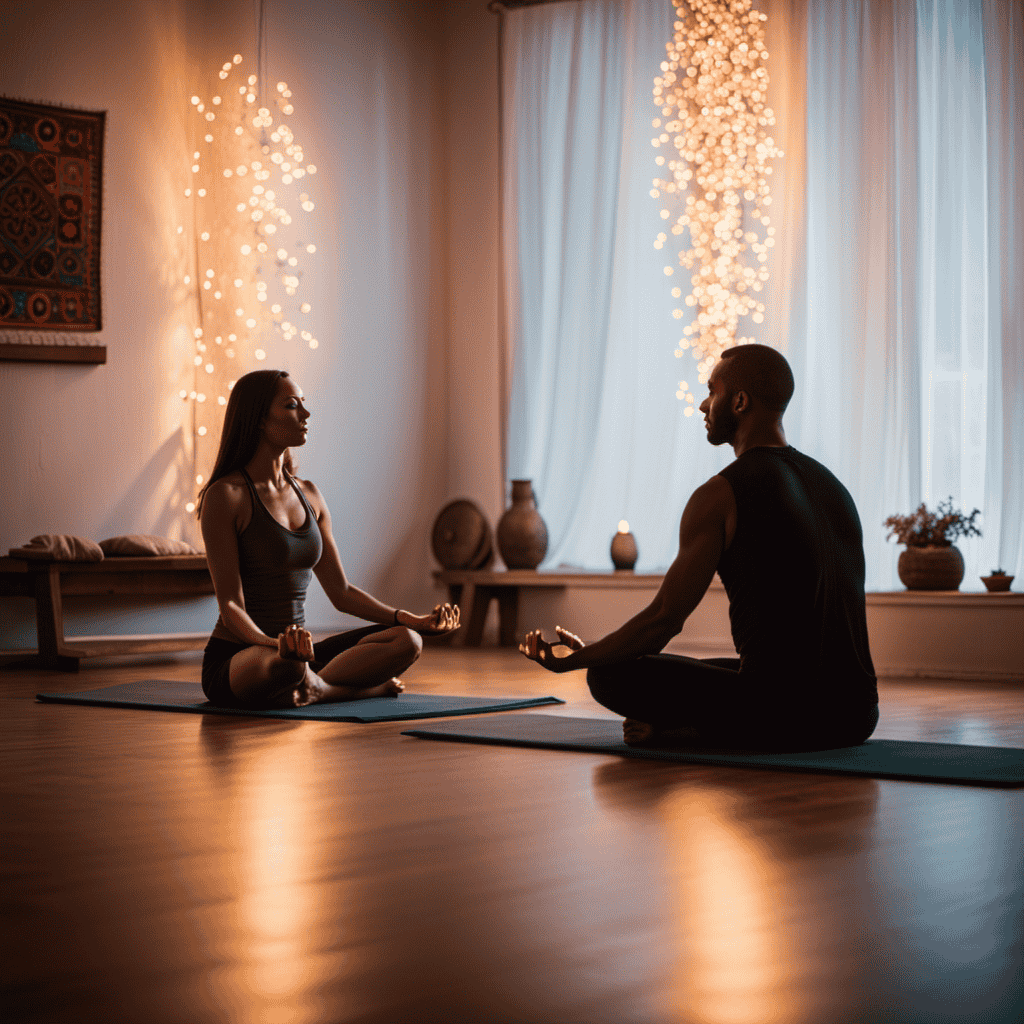Is it possible for the ancient tradition of yoga and the principles of Christianity to peacefully coexist? How can people achieve spiritual equilibrium and inner calm through the combination of these two disciplines?
In this article, I will explore the potential for finding spiritual harmony between yoga and Christianity. By delving into the origins and affiliations of yoga, the spiritual aspects of both practices, and the ways in which they can complement each other, we will discover how individuals can navigate the intersection of yoga and Christianity with discernment and respect.
Key Takeaways
- Yoga originated in India within the framework of Hinduism but has transcended religious boundaries in contemporary times.
- Yoga involves introspection, self-discovery, and mindfulness, and explores the interconnectedness of all beings and the universe.
- The Bible references meditation, and Christian meditation involves contemplating God’s word and seeking guidance to foster a deeper relationship with God.
- Yoga and Christianity can coexist harmoniously with discernment and respect, with Christians focusing on the secular aspects of yoga while remaining true to their faith.
Origins and Affiliation
I know that yoga originated in India within the framework of Hinduism and was influenced by early texts like the Vedas and Upanishads. It holds historical significance in Hindu philosophy and is practiced within the religious and philosophical framework of Hinduism.
However, in contemporary times, yoga has transcended religious boundaries, and people of various faiths and beliefs practice it. Yoga involves introspection, self-discovery, and mindfulness, exploring the interconnectedness of all beings and the universe.
The spiritual dimension of yoga varies depending on individual interpretations and may include meditation, breathwork, and exploring higher states of consciousness. It encompasses a spiritual journey of self-realization.
Understanding the historical and cultural context of yoga is crucial when examining its affiliation with Christianity. By focusing on the secular aspects of yoga, Christians can find a balance and incorporate the physical and mindfulness benefits while remaining true to their faith.
Spiritual Side
Exploring the spiritual side of yoga involves delving into introspection, self-discovery, and mindfulness. It is a journey that allows individuals to tap into their inner selves and connect with the world around them.
Here are four key aspects that highlight the spiritual dimension of yoga:
-
Interconnectedness exploration: Yoga encourages us to recognize the interconnectedness of all beings and the universe. Through various practices such as asanas and pranayama, we can cultivate a sense of unity and oneness with everything around us.
-
Higher states of consciousness: Yoga offers a path to explore higher states of consciousness beyond our everyday awareness. Through meditation and deep introspection, we can access profound levels of spiritual insight, wisdom, and clarity.
-
Mindful presence: Yoga teaches us to be fully present in the moment, cultivating a state of mindfulness. By being aware of our thoughts, emotions, and sensations, we can develop a deeper understanding of ourselves and our connection to the divine.
-
Self-realization: Ultimately, the spiritual journey of yoga leads to self-realization. It is a process of uncovering our true nature and discovering our purpose in life. Through yoga, we can embark on a transformative path of self-discovery, finding inner peace and harmony along the way.
Biblical References
Biblical references provide guidance and encouragement for incorporating meditation into one’s spiritual practice. Interpreting scripture, Christians can find inspiration to engage in meditation as a means of deepening their relationship with God.
In Joshua 1:8, we are encouraged to meditate on the Book of the Law, which can be seen as an invitation to reflect on God’s teachings and seek understanding. Similarly, in Psalm 1:2, we are reminded of the importance of delighting in the law of the Lord and meditating on it.
These passages highlight the value of Christian meditation techniques, such as contemplating God’s word, seeking guidance, and fostering a deeper connection with Him. By incorporating these practices into our spiritual journey, we can find harmony between yoga and Christianity while remaining true to our faith.
Coexistence with Christianity
Understanding the historical and cultural context of yoga is crucial for individuals of the Christian faith to coexist with the practice. Interfaith dialogue is essential in navigating conflicting beliefs and finding common ground. It is important to approach the topic with an open mind and respect for diverse perspectives. While the physical and mindfulness aspects of yoga can offer health benefits, Christians may have concerns about the spiritual elements that do not align with certain teachings. By focusing on the secular aspects of yoga, such as exercise, flexibility, and stress reduction, individuals can find a balance that allows them to practice yoga while remaining true to their faith. Engaging in open and respectful discussions about the differences and similarities between yoga and Christianity can foster understanding and promote harmony among practitioners of both traditions.
| Yoga | Christianity |
|---|---|
| Promotes physical and mental well-being | Emphasizes spiritual growth and salvation |
| Explores interconnectedness and self-discovery | Focuses on a personal relationship with God |
| Can be practiced without incorporating spiritual elements | Encourages meditation on God’s word |
| Transcends religious boundaries | Grounded in the teachings of Jesus Christ |
Secular Aspects
By focusing on the physical and mental benefits of yoga, I can incorporate a secular approach that promotes exercise, flexibility, and stress reduction. Embracing the secular aspects of yoga allows me to tap into its potential to improve my physical well-being. Here are four secular benefits of yoga:
-
Increased strength and flexibility: Through regular practice, yoga helps me build strength in my muscles and improve my flexibility. I can feel my body becoming more toned and agile.
-
Stress reduction: Engaging in yoga poses and mindful breathing techniques helps me release tension and calm my mind. It provides a much-needed escape from the demands of everyday life.
-
Improved posture and balance: Yoga poses require proper alignment, which helps me develop better posture and balance. This not only enhances my physical appearance but also supports overall body functionality.
-
Enhanced body awareness: Yoga encourages me to pay attention to my body’s sensations and limitations. This heightened awareness allows me to make healthier choices and prevent injuries.
Incorporating these secular benefits into my yoga practice allows me to experience physical well-being while staying true to my Christian faith.
Balancing Perspectives
Incorporating a secular approach to yoga allows me to find a balanced perspective that prioritizes my physical and mental well-being.
I believe that interfaith dialogue and respecting diverse perspectives are essential when it comes to finding harmony between yoga and Christianity.
By understanding and acknowledging my personal beliefs, I can navigate the spiritual aspects of yoga in a way that aligns with my faith.
It’s important for me to differentiate between the cultural and historical context of yoga and the religious teachings of Christianity.
This allows me to focus on the secular aspects of yoga, such as exercise, flexibility, and stress reduction, while remaining true to my Christian beliefs.
Through open-mindedness and self-reflection, I can find a middle ground that promotes inner peace and a balanced approach to my yoga practice.
Mindful Approach
Now that we have discussed the importance of balancing perspectives when considering the coexistence of yoga and Christianity, let’s delve into the current subtopic: finding mindfulness and cultivating inner stillness.
In our fast-paced and chaotic world, it is crucial to find moments of stillness and tranquility. Yoga offers a mindful approach to achieving this balance. By incorporating breathing techniques, meditation, and gentle movements, yoga encourages us to be fully present in the moment, allowing us to quiet our minds and connect with our inner selves.
To further illustrate the significance of mindfulness in yoga, let’s take a look at this table:
| Mindfulness | Benefits | Techniques |
|---|---|---|
| Increases self-awareness | Reduces stress and anxiety | Breathing exercises |
| Enhances focus and concentration | Improves emotional well-being | Meditation |
| Cultivates a sense of inner peace | Promotes physical relaxation | Mindful movement |
By incorporating these techniques into our yoga practice, we can cultivate a deep sense of inner stillness and find solace in the present moment.
Achieving Inner Peace
To achieve inner peace, I focus on cultivating mindfulness and stillness through my yoga practice. By deepening my mind-body connection, I am able to find a sense of calm and tranquility within myself. Here are three ways that yoga helps me achieve inner peace:
-
Mindfulness: Through yoga, I am able to bring my full attention to the present moment. By focusing on my breath and the sensations in my body, I am able to let go of distracting thoughts and worries, allowing me to experience a state of deep relaxation.
-
Meditation Techniques: Yoga provides me with various meditation techniques that help quiet my mind and find inner peace. Whether it’s through guided visualization or mantra repetition, these techniques allow me to access a state of deep inner stillness and connect with my inner self.
-
Balancing Energy: Through yoga poses and breathwork, I am able to balance and harmonize the energy within my body. This helps release tension and promote a sense of balance and peace.
By incorporating these practices into my yoga routine, I am able to achieve a greater sense of inner peace and harmony in my life.
Frequently Asked Questions
Can yoga be practiced by Christians without compromising their faith?
Yes, yoga can be practiced by Christians without compromising their faith. Yoga’s impact on mental health and the role of mindfulness in yoga practice can benefit Christians in achieving inner peace and well-being.
How can Christians incorporate the physical aspects of yoga while remaining true to their Christian beliefs?
Balancing physical and spiritual practices can be achieved by exploring Christian yoga communities. These communities integrate the physical aspects of yoga while staying true to Christian beliefs, creating a space where both can coexist harmoniously.
What is the historical and cultural context of yoga, and why is it important for Christians to understand?
The historical significance of yoga lies in its origins within Hinduism and its development through texts like the Vedas. Understanding its cultural implications is important for Christians to navigate its spiritual elements while remaining true to their faith.
How can Christians find a balance between embracing the health benefits of yoga and discerning the spiritual elements that may not align with their beliefs?
To find balance, Christians can explore the philosophical foundations of yoga and assess its compatibility with their beliefs. They can approach meditation from a biblical perspective, focusing on seeking guidance and deepening their relationship with God.
What are some alternative practices or exercises that Christians can engage in if they feel uncomfortable with yoga’s spiritual aspects?
If Christians feel uncomfortable with yoga’s spiritual aspects, they can explore alternative exercises such as Pilates, Tai Chi, or simple mindful movement practices. These activities can promote physical and mental well-being without conflicting with their beliefs.
Conclusion
In conclusion, finding spiritual harmony between yoga and Christianity is possible through open dialogue and a balanced approach.
By focusing on the secular aspects of yoga such as physical exercise and stress reduction, Christians can incorporate yoga into their lives while remaining true to their faith.
For example, Sarah, a devoted Christian, found that practicing yoga helped her improve her physical health and reduce anxiety, while still maintaining her strong connection with God.
By understanding the historical and cultural context of yoga and approaching it mindfully, individuals can achieve inner peace and deepen their relationship with God.









